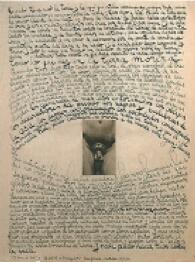León Ferrari
Haunch of Venison, New York
In 1964 León Ferrari began his Manuscripts series choosing outdated words whose resonance he found more interesting than their meaning: words and texts capable of evoking rather than describing. This marked the beginning of a study of the line and the power of expression of the written word, capable of evoking all kinds of qualities and emotions.

That same year he created The Impregnating Tree, which was focused − like many of his earlier works − on the authority exerted by the power of words and on religious control (of sexuality). While this work opens Ferrari’s exhibition at Haunch of Venison New York − the Argentine artist’s first solo show in a New York gallery after his exhibition at the MoMA in 2009 − it does not accurately anticipate the gallery’s main body of work. The latter places the emphasis on the almost musical gestural quality we insisted upon previously, in such a way that the political content implicit in Ferrari’s work seems to be pushed slightly to the background.
In the course of his career, Ferrari would develop a gestural language conveyed through diverse mediums, as we may witness in his exhibition, ranging from his “written” drawings, his drawings and collages, to his wire and steel sculptures. Among his drawings, different studies of the 1960s and 1970s may be found − some of them apparently seeking to establish new alphabets − which precede larger works from the first decade of the 21st century − in which the canvas or the paper is flooded with an almost automatic semi-calligraphy infused with a frenzied rhythm. Such is the case of the 2007 works featuring dripped-paint patterns, like Untitled (with the phrase “The let- ter to the Pope” written on one of the sides of the canvas). Particularly noteworthy among his sculpture pieces are Berimbau, 2010, never exhibited before in the United States, several untitled works from the same year, and Opus 113, cre- ated in 1980, and which marked Ferrari’s return to sculpture − with which he had initiated his career. Some of these works make reference to organic forms inducing beautiful tactile qualities, while others suggest a more formalist aesthetics. Such is the case of Berimbau, which references a percussion instrument used in capoeira, but which was conceived, however, to allow the viewer to enter into it and enjoy its tactile qualities − contradicting its apparent rigidity through a questioning, once again, of the dogmas of codes and conventions.





